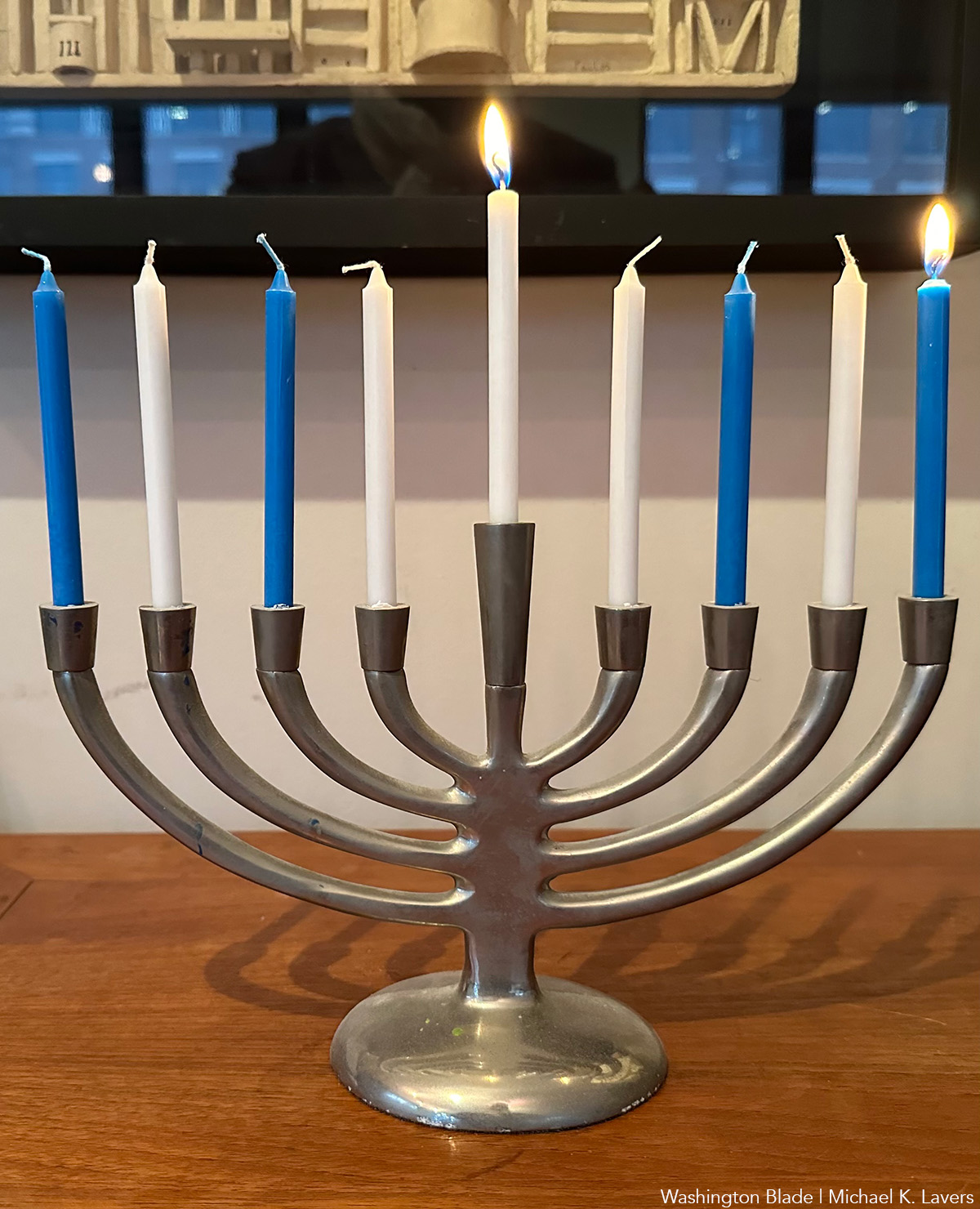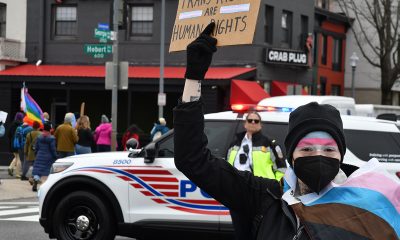Local
Gay engineer’s death ruled a homicide
Cause of death was ‘impact head trauma’

The D.C. Medical Examiner disclosed on Tuesday that gay engineer Gaurav Gopalan, who was found dead Sept. 10 on a sidewalk in Columbia Heights at 5:20 a.m., died of blunt force trauma to the head and that the death has been ruled a homicide.
News that Gopalan’s death was due to an act of violence came after D.C. police initially announced there were no obvious signs of injuries on Gopalan’s body and that a final determination on the death would have to wait for results of toxicological tests.
Gopalan, a native of India, was found dead on the 2600 block of 11th Street, N.W. in a location less than two blocks from where he lived. He was dressed in women’s clothes with some facial makeup, prompting police to initially describe him as a transgender woman.
With no identification on him, it took police three days to track down his identity following the release of a post mortem photo taken by the Medical Examiner’s office.
It could not be immediately determined why the Medical Examiner’s office didn’t disclose last week its findings released today that Gopalan suffered a “subarachnoid hemorrhage,” or internal head bleeding, due to “blunt impact head trauma.”
Beverly Fields, a spokesperson for the Medical Examiner’s Office, said the latest findings were based on the autopsy conducted last week.
Bob Shaeffer, Gopalan’s partner, told the Blade Monday that he didn’t know where Gopalan had been on the night before his death but said police told him they obtained video footage of Gopalan near the corner of Florida Avenue and U Street, N.W. The gay nightclub Town and the gay sports bar Nellie’s are located in that area.
Police last week said they had contacted the management of several gay clubs in the city to ask whether Gopalan had been seen in the clubs in the hours prior to his death. At a news conference last week, Homicide Branch Capt. Michael Farish said representatives of the clubs weren’t certain whether Gopalan had visited the clubs.
Gopalan received a doctorate degree in aeronautical engineering at the University of Maryland and later worked with the university on research projects related to sound suppression of helicopter rotor blades, a technology deemed important for U.S. military applications.
Officials with the University of Maryland’s school of engineering and D.C.’s South Asian LGBT group Khush D.C., to which Gopalan had ties, this week continued to mourn Gopalan’s death.
He also served as president of the Fred Schmitz Group, an aeronautical engineering consulting firm, which he operated out of the home that he and Shaeffer shared in Columbia Heights.
Rehan Rizvi, a member of Khush D.C., said Gopalan attended a number of the group’s events during the past few years.
Rizvi said Khush D.C. planned to coordinate a possible memorial service for Gopalan with the University of Maryland’s engineering school, which was expected to host a memorial at the campus.
People who knew Gopalan said he also served as an assistant director and stage manager for Shakespeare plays produced by a the WSC Avant Bard theater group formerly known as the Washington Shakespeare Company.
The ruling of his death as a homicide is certain to further alarm LGBT activists. Gopalan’s death followed shootings and an attempted shooting of at least five transgender women since July. One of the women, Lashai Mclean, 23, was shot to death on July 20th on the 6100 block of Dix Street, N.E.
Police have said they have no evidence so far to indicate any of the incidents are linked to the same perpetrator.
Gay D.C. Council member Jim Graham (D-Ward 1), who represents the area where Gopalan lived and died, said he is closely monitoring the police investigation.
“Now our determination must be to get the killer because somebody killed this fine young man who had such a great life and was loved by so many people,” he said. “We have got to get this killer”
District of Columbia
New queer bar Rush beset by troubles; liquor license suspended
Staff claim they haven’t been paid, turn to GoFundMe as holidays approach

The D.C. Alcoholic Beverage and Cannabis Board on Dec. 17 issued an order suspending the liquor license for the recently opened LGBTQ bar and nightclub Rush on grounds that it failed to pay a required annual licensing fee.
Rush held its grand opening on Dec. 5 on the second and third floors of a building at 2001 14 Street, N.W., with its entrance around the corner on U Street next to the existing LGBTQ dance club Bunker.
It describes itself on its website as offering “art-pop aesthetics, high-energy nights” in a space that “celebrates queer culture without holding back.” It includes a large dance floor and a lounge area with sofas and chairs.
Jackson Mosley, Rush’s principal owner, did not immediately respond to a phone message from the Washington Blade seeking his comment on the license suspension.
The ABC Board’s order states, “The basis for this Order is that a review of the Board’s official records by the Alcoholic Beverage and Cannabis Administration (ABCA) has determined that the Respondent’s renewal payment check was returned unpaid and alternative payment was not submitted.”
The three-page order adds, “Notwithstanding ABCA’s efforts to notify the Respondent of the renewal payment check return, the Respondent failed to pay the license fee for the period of 2025 to 2026 for its Retailer’s Class CT license. Therefore, the Respondent’s license has been SUSPENDED until the Respondent pays the license fees and the $50.00 per day fine imposed by the Board for late payment.”
ABCA spokesperson Mary McNamara told the Blade that the check from Rush that was returned without payment was for $12,687, which she said was based on Rush’s decision to pay the license fee for four years. She said that for Rush to get its liquor license reinstated it must now pay $3,819 for a one-year license fee plus a $100 bounced check fee, a $750 late fee, and $230 transfer fee, at a total of $4,919 due.
Under D.C. law, bars, restaurants and other businesses that normally serve alcoholic beverages can remain open without a city liquor license as long as they do not sell or serve alcohol.
But D.C. drag performer John Marsh, who performs under the name Cake Pop and who is among the Rush employees, said Rush did not open on Wednesday, Dec. 17, the day the liquor board order was issued. He said that when it first opened, Rush limited its operating days from Wednesday through Sunday and was not open Mondays and Tuesdays.
Marsh also said none of the Rush employees received what was to be their first monthly salary payment on Dec. 15. He said approximately 20 employees set up a GoFundMe fundraising site to raise money to help sustain them during the holiday period after assuming they will not be paid.
He said he doubted that any of the employees would return to work in the unlikely case that Mosley would attempt to reopen Rush without serving liquor or if he were to pay the licensing fee to allow him to resume serving alcohol without having received their salary payment.
As if all that were not enough, Mosley would be facing yet another less serious problem related to the Rush policy of not accepting cash payments from customers and only accepting credit card payments. A D.C. law that went into effect Jan. 1, 2025, prohibits retail businesses such as restaurants and bars from not accepting cash payments.
A spokesperson for the D.C. Department of Licensing and Consumer Protection, which is in charge of enforcing that law, couldn’t immediately be reached to determine what the penalty is for a violation of the law requiring that type of business to accept cash payments.
The employee GoFundMe site, which includes messages from several of the employees, can be accessed here.
District of Columbia
Brian Footer suspends campaign for Ward 1 D.C. Council seat
Race’s third LGBTQ candidate cites family reasons for ‘stepping back’

Gay Advisory Neighborhood Commissioner Brian Footer, who was one of three out LGBTQ candidates running for the open Ward 1 D.C. Council seat in the city’s June 16, 2026, Democratic primary, announced on Dec. 17 he has decided to “suspend” his campaign to focus on his family.
“After deep reflection and honest conversations with my family, I have decided to suspend my campaign for the D.C. Council,” he said in a statement. “This moment in my life requires me to be present with the people I love most and honor the responsibilities I carry both at home and in the community,” he states. “This was not an easy decision, but it is the right one for me and my family at this time.”
Footer, a longtime Ward 1 community activist and LGBTQ rights advocate, announced his candidacy for the Ward 1 Council seat in July, one month before bisexual Ward 1 community activist Aparna Raj announced her candidacy for the Council seat on Aug. 12.
Gay Ward 1 Advisory Neighborhood Commissioner Miguel Trindade Deramo announced his candidacy for the Ward 1 Council seat on Nov. 18, becoming the third out LGBTQ candidate in what appeared to be an unprecedented development for a race for a single D.C. Council seat.
At least three other candidates who are not LGBTQ are running for the Ward 1 Council seat. They include Ward 1 ANC member Rashida Brown, longtime Ward 1 community activist Terry Lynch, and Jackie Reyes-Yanes, the former director of the Mayor’s Office of Community Affairs.
In his statement announcing the suspension of his candidacy, Footer said he would continue to be involved in community affairs and advocate for the issues he discussed during his campaign.
“I want to be clear: I am stepping back from the race, not the work,” he says in his statement. “Public service has always been my calling. I will continue advocating for affordability, for safer streets, for stability for small businesses, and for a government that responds to people with urgency and respect,” he wrote. “And I will continue showing up as a partner in the work of building a stronger Ward 1.”
Footer concluded by thanking and praising his campaign supporters and calling his campaign suspension a “transition,” suggesting he is not likely to resume his candidacy.
His campaign press spokesperson did not immediately respond to a question from the Washington Blade asking if Footer might later resume his campaign or if his latest action was in effect an end to his candidacy.
“To everyone who knocked on doors, hosted conversations, donated, shared encouragement, and believed in this campaign, thank you,” he says in his statement. “I am deeply grateful for every person who helped this campaign take root,” he added. “This isn’t an ending, it’s a transition. And I’m excited for the work ahead, both in Ward 1 and at home with my family.”
Longtime gay D.C. Democratic Party activist Peter Rosenstein said in a statement to the Blade, “I respect Brian Footer’s decision to end his campaign for Council. It is not easy to run a campaign in D.C. and there are many others running in Ward 1.” He added, “While not living in Ward 1, I thank Brian for all he has done and clearly will continue to do for the people in the ward.”
Local
LGBTQ, LGBTQ-friendly congregations to hold holiday services
Bet Mishpachah’s Hanukkah service to take place on Friday

LGBTQ and LGBTQ-friendly congregations in D.C. will hold services and other events throughout the holiday season.
Bet Mishpachah on Friday will hold its Sparks in the Dark Happy Hour at Spark Social on 14th Street from 5:30-7:30 p.m. It’s Chanuka Shabbat Service will begin at the Edlavitch DC Jewish Community Center (1529 16th St., N.W.) at 8 p.m.
Hanukkah began on Sunday and will end on Dec. 22.
Two gunmen on Sunday killed 15 people and injured more than two dozen others when they opened fire at a Hanukkah celebration on Sydney’s Bondi Beach.
Jake Singer-Beilin, Bet Mishpachah’s chief rabbi, in a Facebook post mourned the victims.
“We grieve for the victims and send heartfelt prayers of healing for those who were wounded,” he wrote.
“This Chanuka, our lights will shine brightly in the darkness, but our hearts will be heavy with mourning for those who were murdered on Bondi Beach while observing what should have been a joyous day,” added Singer-Beilin. “We will still celebrate our Festival of Lights and we will commit ourselves to illuminating and repairing our broken world. Let us channel the bravery of the Maccabees who found hope where there seemed to be none, and who fought to create a better future. We must do the same.”
LGBTQ Catholic group to hold annual Christmas Day Mass
Dignity Washington’s Christmas Day Mass will take place at St. Margaret’s Episcopal Church (1820 Connecticut Ave., N.W.) on Dec. 25 from 6-7 p.m. Parishioners can attend in person or watch it online via Facebook.
The Metropolitan Community Church of Washington D.C.’s Christmas Eve service will take place at the church (474 Ridge St., N.W., on Dec. 24 at 6 p.m.
St. Thomas Episcopal Church (1517 18th St., N.W.) in Dupont Circle will hold its Christmas Eve Festival Eucharist from 5-6 p.m. A Christmas Eve dinner will take place in the Parish Hall from 6-8:30 p.m. The church’s Christmas Eve Festival Eucharist will occur on Dec. 25 from 10-11 a.m.
Washington National Cathedral throughout the holiday season has a number of services and events scheduled. These include the virtual Gospel Christmas Service on Dec. 21 from 6-7:30 p.m., the Family Christmas Service on Dec. 23 from 11 a.m. to noon, the Christmas Eve Festival Holy Eucharist on Dec. 24 from 10-11:45 p.m., and the Christmas Day Festival Holy Eucharist on Dec. 25 from 11:15 a.m. to 12:45 p.m.
The Foundry United Methodist Church (1500 16th St., N.W.) in Dupont Circle will hold its Christmas Eve Family Service on Dec. 24 at 4:30 p.m. Its Carols and Candlelight Service will take place at 8 p.m.
Smithsonian Anacostia Community Museum to celebrate Kwanzaa
The Smithsonian Anacostia Community Museum (1901 Fort Place S.E.) in Anacostia will mark the first day of Kwanzaa on Dec. 26 with storytelling and drumming with Mama Ayo and Baba Ras D from noon to 2 p.m. The museum will hold a series of other events through the 6-day celebration of African American culture that ends on Jan. 1.
The Creative Suitland Arts Center (4719 Silver Hill Road) in Suitland, Md., on Friday will hold their Almost Kwanzaa: A Creative Kind of Holiday event from 6-8:30 p.m.


















